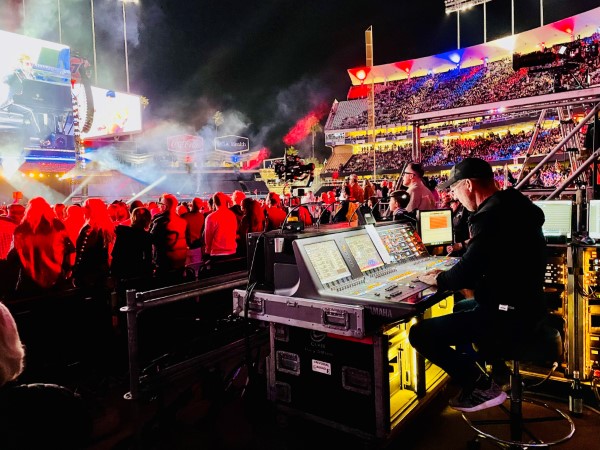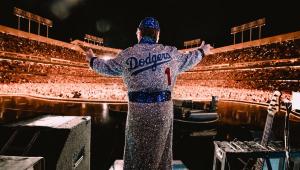Elton John: Farewell Yellow Brick Road Page 2

Woodroffe, in fact, was keen to use them even more. “I realized, very quickly, that we should have the extra diamond screens on all the time, because they look so great. We could have very simple material on them, to complement Sam’s beautiful content, and it would stretch our stage out and additional 40 or 50 feet each side. For instance, for ‘Candle in the Wind,’ I could take the same piece of film that Sam had given us, and put it on our two side screens. Just put those candles on the extra screens. Or for ‘Rocket Man,’ when we suddenly see the moon or the Earth coming up, we would now spread them over all five screens. And Sam’s team did a remarkable job, back in London, mapping all of that out, just three or four nights before the show.”
Treatment also made use of the “ribbon” LED screens which spanned around the entire front edge of the stadium’s Loge level. The artists would also create graphic frames for particular songs. “’Burn Down the Mission’ is particularly IMAG heavy,” Pattinson explains. “We just did a very simple effect—and overlay of fire, so that Elton’s piano starts to catch fire.” The effect appears at a particular point in the song, so Pattinson coordinated with Steer to assure that his camera operator would have that shot—and hold it—at the precise time the fire effect was activated. “He had to have his camera in precisely the same position every night, right at that time, so that the content lines up—and then hold it, say, for 20 seconds for us. It worked pretty well.”
The approach to each song’s video content was always unique, indeed giving each song its own identity and experience for the audience. “That’s the goal, really,” says Pattinson. “And Elton’s repertoire is so varied that you’ve got to respond to that. So often, visuals are just screen fillers. A lot of people do the same thing again and again. We try not to repeat, strive to do new, original work, and do it very well.”
As for the films themselves, they were made by an accomplished set of filmmakers, from all different worlds. While, at one time, Treatment Studio had a roster of 10 in-house directors, Pattinson says the company realized that wasn’t always the best route. “One was busy, two did all right, and the rest were starving. And irritable,” he notes. “And you’re forcing them to do work that wasn’t right for them, and forcing clients to take creatives that weren’t right for their job. But now, we’ve got a really great network of freelancers. If we need hand drawn animation, for instance, we know where to go. We can bring people in, and they do fantastic work.”

After the animated intro for “Benny and The Jets,” drafted by illustrator Richard Killroy, the show leaps into action with “Philadelphia Freedom.” That film was shot in Brooklyn by director Sammy Rawal, and features, as Pattinson says of Furnish’s brief, “Imagine a party, where everybody was invited.” The film is packed with a wide variety of dancers, joyfully partying it up. “Elton sees an America where everything is possible for everyone,” Furnish notes. “He said, ‘America allowed me to become everything that I wanted to be. America gave me everything.’ And we wanted to capture that same spirit—a spirit of diversity, of possibility.”
“I Guess That’s Why They Call It The Blues” features photography by great British photographer Martin Parr—whose work Elton has collected since he got sober in 1990, Furnish notes.
“Someone Saved My Life Tonight” brings to life via animation the original artwork by beloved rock artist Alan Aldridge, from his cover design forCaptain Fantastic and The Brown Dirt Cowboy .
One of the biggest pieces was crafted for “Rocket Man,” made by animator Terry Scruby. “Sam gave us a wonderful space scene—a beautiful journey as we move through the planets,” Woodroffe explains. “We then matched the lighting to extend the effect into the audience, using breakup patterns to precisely match the same color, pitch and movement as Terry’s animation. Sam’s team then gave us additional content to continue on the stadium’s ‘ribbon’ screens, all the way around.” To top things off, audience members wore LED wristbands, twinkling as a field of stars (see below for more description). “The audience doesn’t know what they’re looking at. They just know that they’re in outer space.”
“It was a big fiery star, as if the rocket was igniting and taking off, going into space,” adds Pattinson. “A lot of work went into it. It’s a triptych of the Earth, looking back at the Earth, across three screens.” Since the band enjoys playing the song so much, its length can vary anywhere from six to 12 minutes, “So we had to build it in a way that we can continually loop, to populate their performance.”
“Crocodile Rock” is packed with fans, happily displaying their favorite Elton mementos. Inspired by West African photographer Malick Sidbé, known for taking images of everyday people with items that express their character, Furnish explains, “We had a competition—‘Do you want to be in the ‘Farewell Yellow Brick Road’ show?’ People entered, and came to the studio we set up in London, with iconic Elton clothing items and memorabilia. It gave everybody a chance to have their own Elton moment, in front of the camera.” This was then supplemented with live images of fans in the stadium’s audience doing the very same.
Two pieces—“Your Song” and “I’m Still Standing” featured personal images and items of Elton’s own choosing, representing every aspect of his life and career—“Your Song” with photos he chose, and the other with content representing everything the artist has worked on over the decades, including South Park, The Muppet Show, The Queen’s Birthday Celebration and much more. “Elton is really into GIPHY, which creates little animations, so we based it on that,” notes Pattinson. “And we did a ton of research, from his whole career. We really dug in.”
“Tiny Dancer” is from a set of videos Elton had commissioned eight years prior for songs which, at the time of their release, never had a music video, because the practice didn’t really exist yet. “We did a competition with YouTube, called ‘The Cut,’” Furnish explains. “And it was for young filmmakers to make official videos for iconic Elton tracks,” including “Tiny Dancer,” “Rocket Man” and “Benny and The Jets.” Filmmaker Max Weiland created one which brought together several individual stories of people’s life in L.A. “Neither Elton nor I are fans of throwing things out for the sake of it. A great film is a great film.”

Photographer David LaChappelle had created a moving film for “Candle in the Wind” for Elton’s “Red Piano” residency show in Las Vegas, which was reused here, as well, along with another for “Daniel.” “It absolutely captures the spirit of the song and the subject. And a lot of people, who never saw the ‘Red Piano’ show, were now getting to see it for the first time,” Furnish informs.
The Sound of Elton in the House
The live sound reinforcement for the tour is immaculate and powerful, and it’s not surprising why. “If there’s one thing that Elton is obsessive about, it’s great sound,” says Furnish. “He always wants his show to be the best possible sound for his fans, as well as for a broadcast audience.”
Thankfully, he had a 20-year Elton veteran with him, front-of-house (FOH) mixer Matt Herr. Besides being on the road, Herr also mixed Elton’s two Las Vegas residencies—“The Red Piano” from 2004 to 2009 and “The Million Dollar Piano” from 2011 to 2018. “They have a great friendship,” Furnish notes. “They’re always swapping baseball scores. And Matt just knows how to get those shows absolutely optimal.”
Herr had been mixing for years using an analog console, a Yamaha PM5000. “But when Ray Cooper joined the Vegas residency, that required a lot more inputs, so I had two mixers. And then, when we went out on the road, I figured they didn’t want two, so I swapped it for a Yamaha Rivage PM10” Digital Mixing System.
Input-wise, indeed, Cooper requires 28 microphones, to cover his five tympanis, three congas, rototoms, tubular bells and more. And that’s just part of the 80 inputs Herr has to manage, including a dozen for drummer Nigel Olsson, 10 for second percussionist John Mahon and many more.

Elton’s vocal mic of choice (and for the whole band) is the Audio-Technica Artist Elite 6100 hypercardioid dynamic microphone, providing a rich, powerful vocal., and one with a tight enough pickup pattern to reject the output of Elton’s monitor speakers.
His piano, interestingly enough, is not miked. The beautiful Yamaha CFIII 9 ft. grand piano—one of five available for use—actually comes fitted from the factory with a MIDI light bar. Key strikes trigger the MIDI, both in note and intensity, for which the sounds of the piano are then generated by a rack with two synthesizers—a Yamaha MOTIF-RACK SX Rackmount Synthesizer and a Roland MKS, which have several rich, preferred piano sounds they provide. “The advantage of that system is that you can get the low end of the piano, his left hand, to really hit you in the chest,” says Herr. “And also, his monitors are so loud, you’d never be able to get microphones or pickups to work, without getting feedback. It would just be a wash.”
Within keyboardist Kim Bullard’s rig are some key samples—notably the robust vocal choruses for songs like “Rocket Man.” “The guys actually got together at Kim’s house and recorded those vocals. And then, Kim tweaks them and pops them into his keyboard,” for playback at the appropriate times in the song.
With that single exception, the show is completely live—the band does not play to a click track in their monitors, as do so many performers these days. “That is a lost art today. You don’t see many bands going 100% live. It’s very free, very organic. They’re just a really great, tight, old school rock and roll band. And you never know where they’ll go—Elton doesn’t even know. On ‘Rocket Man,’ for instance, you get through the 2nd verse, and the song drops, and everyone’s following Elton. And no one knows what he’s going to do. He’s just improvising as he goes, with everyone just following him. And that’s what makes it so special.”

Herr is following along, the same as the band. “I’m following, too, just trying to make it dynamic. All I’ve got is a P.A., so I try to make the P.A. an instrument itself, so it can breathe and be dynamic, and create a bit of excitement.” And even though a digital mixing system like his could allow him to store audio “scenes”—pre-made mixes for each song—Herr doesn’t use them. “It’s a very visceral experience, what they do. So I do real mixing, by hand. I don’t set compressors to balance everything. It’s legit pushing and pulling,” riding the instruments’ faders by hand and by ear. “I turn down two things to make one thing pop. If they’re jamming, I can tell, by what he’s playing, the direction they’re gonna go. So I can push a guitar a little bit more, or make the piano sneak in there a little bit more. You just go by feel. It’s that kind of old school mixing.”
The historic moment of the concert wasn’t lost on the veteran mixer. “It was very emotional,” he says. “20 years is a long time to be with a group. Elton and everyone, it’s like a big family. And knowing we were ending in America was definitely a big thing to realize.”














































